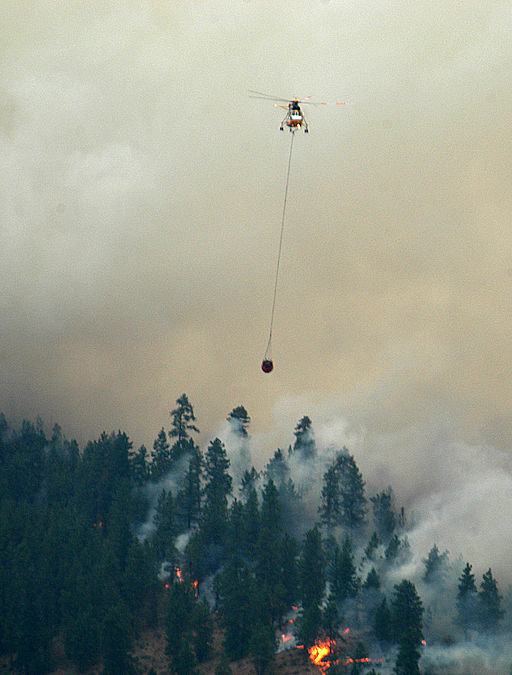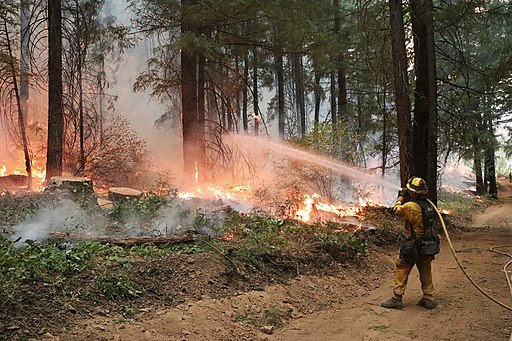Wildfires are natural circumstances that can have devastating consequences for communities and ecosystems. While they are a part of many ecosystems, they can also seriously threaten human safety.
According to the National Interagency Fire Center, nearly 85% of wildland fires in the United States are caused by humans. Fires can happen for many reasons, like when someone doesn’t watch their campfire, burns trash or brush, uses equipment that doesn’t work right, throws away a cigarette without putting it out, or starts a fire on purpose.

Collaboration in action: The BLM and U.S. Forest Service join forces to effectively manage wildfires.
This scenario emphasizes the importance of prevention measures, such as properly extinguishing campfires and being careful with equipment and cigarettes to reduce the risk of human-caused wildfires. It’s also crucial for communities to be prepared for the possibility of human-caused wildfires and have systems in place to detect and respond to these fires quickly.
In this blog post, we’ll take a step-by-step look at the process of extinguishing a wildfire and the strategies firefighters use to keep communities safe.
Step 1: Preparation
Preparation is key when it comes to fighting wildfires. Firefighters must be constantly aware of their surroundings and anticipate potential hazards to stay safe and effectively control the fire. Firefighters need to understand the various factors that can contribute to a wildfire. By being aware of these potential hazards, firefighters can be better prepared to respond to and control a wildfire.
Back to Basics
To effectively put out a wildfire, firefighters must understand the basic principles of fire behavior. One of the most fundamental concepts in firefighting is the fire triangle, which consists of oxygen, fuel, and heat. All three elements of the fire triangle must be present for a fire to burn. Removing at least one of the elements will extinguish the fire.
Firefighters can use this understanding of the fire triangle to their advantage when fighting a wildfire. For example, they may use water to cool the fuel and remove heat or a fire retardant to coat the fuel and prevent it from igniting. By understanding how the fire triangle works, firefighters can develop strategies to control and extinguish a wildfire successfully.

Managing the risk: USFWS firefighter Brian Pippin from St. Marks National Wildlife Refuge carries out a prescribed fire using a driptorch to reduce wildfire risk and improve wildlife habitat
First Steps
One of the first steps firefighters can take to prevent wildfires is managing the vegetation in an area. By removing excess fuel from the landscape, firefighters can reduce the risk of a wildfire spreading.
Controlled Burn
Controlled burns, or low-intensity fires, are one way to remove excess fuel, as these fires burn away dead leaves and combustible material that can fuel a wildfire. By eliminating this fuel, firefighters can reduce the risk of a wildfire spreading.
Fire Break
In addition to managing vegetation, firefighters can also construct control lines or fire breaks to help contain a wildfire.
Control lines serve as barriers to help stop a wildfire from spreading. To create these lines, firefighters use a variety of methods, such as digging a trench, clearing vegetation, or using a fire retardant. By constructing control lines, firefighters can disrupt the fire triangle and remove one of the three elements needed for a fire to burn: fuel.

A bird’s eye view: The Alder Fire in Yellowstone National Park as seen from above, 2013.
Step 2: Detection
The Incident Commander plays a crucial role in sizing up the fire and determining the appropriate strategy and tactics. Factors to be considered include the type of fuels present, the terrain, the weather conditions, the size of the fire, and the behavior of the fire.
There are several strategies that wildland firefighters may use to control wildfires. One option is a direct attack, in which firefighters work to extinguish the flames of the fire directly. Another option is an indirect attack, in which firefighters work to remove burning embers and other burning fuel from the area around the fire to starve it of fuel and extinguish it.
Fire managers must consider the main fire and any other smaller fires that may be burning in the area. This may involve physically removing combustible material or burning materials from the site to slow the fire’s spread. Ground crews may also be deployed to fight the fire directly, using tools such as shovels and rakes to extinguish flames.
Step 3: Suppression
Suppression is the third step in the process of fighting wildland fires. Several resources used in suppression efforts include fire crews, engines, and helicopters.

Tackling the Delta Fire: Firefighters engage in suppression and incident management activities north of Redding, California.
There are several techniques that wildland firefighters may use to extinguish a fire. As mentioned earlier, one common practice is creating a fireline, a line of cleared ground that serves as a barrier to the oncoming fire. Firefighters also use controlled burning, a technique in which small controlled fires are set in the path of the main fire to consume fuel and slow its spread.
Fire suppression aims to control or extinguish the fire as safely and effectively as possible. It involves a variety of different strategies and techniques, depending on the specific circumstances of the fire.
Step 4: Mopping up
After the main fire has been controlled, firefighters work to ensure that all burning embers, or hot spots, are extinguished. Mopping up is important to prevent the fire from rekindling or spreading.
Firefighters use techniques such as cold trailing to locate and extinguish hot spots. In cold trailing, firefighters walk along the fire line, using a tool such as a shovel to dig into the ground and expose burning embers. They then extinguish the embers by covering them with dirt or water.
Infrared scanning is another tool used to identify hot spots. This technology uses sensors to detect heat signatures, allowing firefighters to locate and extinguish hot spots that may be hidden under debris or in hard-to-reach areas.

Managing the aftermath: Firefighters work to mop up, patrol, and rehabilitate fire lines on the north and northwest flanks of the fire, using hand and aerial ignition to halt the fire advance. Efforts continue along the entire fire perimeter.
Step 5: Rehabilitation
Rehabilitation is restoring the area affected by a wildfire to its natural state. This step is vital in preventing future wildfires and promoting ecosystem recovery.
Several steps are taken in the rehabilitation process after a wildfire has been contained. These may include:
1. Assessing the damage
Firefighters and land management agencies assess the damage caused by the wildfire to determine the extent of the rehabilitation efforts needed.
2. Controlling erosion
The community administers erosion control measures to prevent soil erosion and protect waterways from sediment and debris. These may involve placing straw or other mulch on the ground or installing erosion control structures such as check dams.
3. Planting native vegetation
Native vegetation restores the natural habitat and promote the recovery of the ecosystem.
4. Removing debris
Burned trees, branches, and other debris may be removed to make the area safe for visitors and prevent the spreading of diseases.
5. Monitoring the area
Firefighters and land management agencies may continue to monitor the site to ensure that the rehabilitation efforts are successful and to identify any additional steps that may be needed.
Fighting wildfires is a complex process involving various techniques and strategies to control and extinguish the flames. Firefighters train to respond to and control wildfires, but prevention and preparedness are keys in mitigating the impact of these events.


